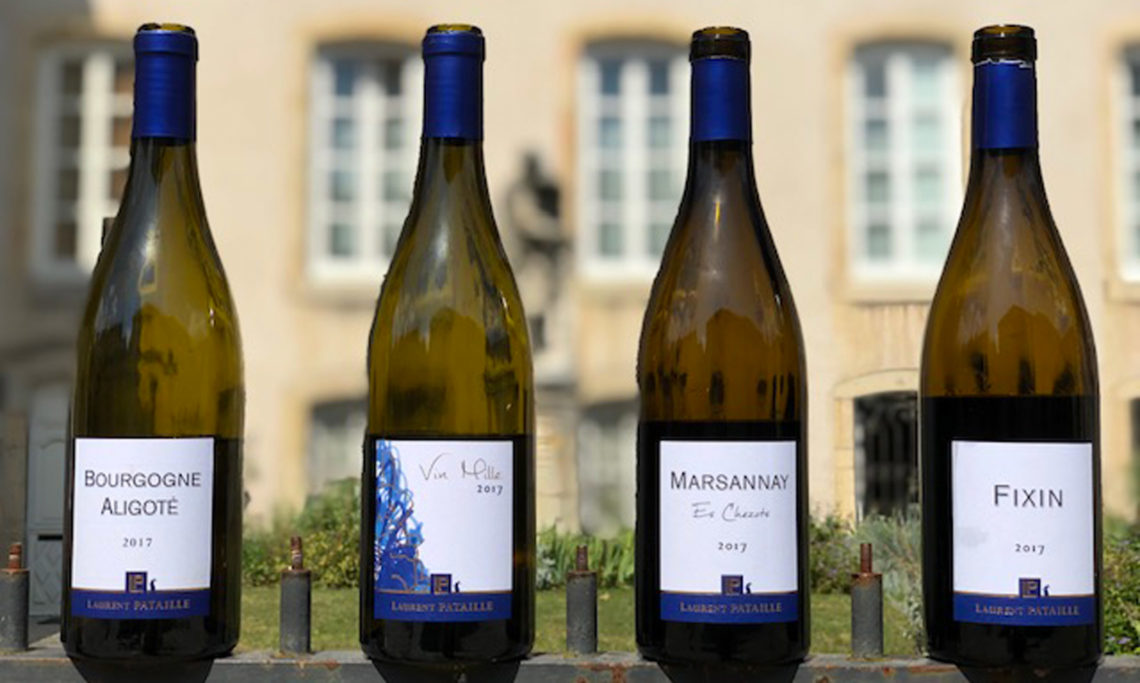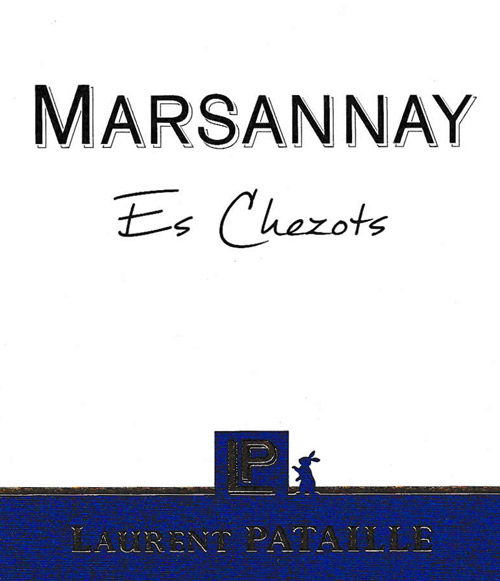Domaine Profile
- Location: Marsannay-la-Côte, Côte de Nuits, Burgundy
- Size: 1 ha (2.47 ac)
- Varieties: Pinot Noir, Aligoté
- Viticulture: Organic since 2010, certified in 2023 (Ecocert), biodynamic methods
- Vinification (Whites): Grapes are crushed and pressed 5-6 hours in a basket press. Ambient yeast fermentation with no added SO2 at vinification. Aged in tank and/or barrels for about 12 months. SO2 added at racking (25-40 mg/l total).
- Vinification (Reds): Partial to total whole cluster with some crushing. Ambient yeast fermentation with no added SO2 at vinfication. Short maceration (about 15 days) with mostly pump-overs. Aged for about 18 months in barrels. SO2 added at racking (25-40 ppm total).
Background
Laurent is Sylvain’s younger brother. He has similar hair and makes wine too, but his is much harder to find. He farms only one hectare and the five cuvées he makes mostly end up in Japan.
Laurent was born in 1978; Sylvain in 1975. It was somewhat unexpected for both of them to become winemakers since there were almost no family vineyards. Their father was a bus driver. His morning shift left him with free time in the afternoon. He occupied it by assisting his vigneron friend Jean Fournier. In the 1980s, he bought a few scraps of vineyards, just a half acre.
From a very young age, the brothers could not wait for school to be over when they would run to find their father in his vines or Fournier’s. Their paternal great uncle owned a more substantial domaine in the Médoc that the Patailles visited for two weeks every summer.
Laurent attended the viticulture and enology school in Beaune, then the University in Dijon for his enology degree. His internships included Château Calon in Saint-Emilion and Réné Muré in Alsace. He furthered his studies with a Masters in Business Management in Bordeaux at the outset of which he became the régisseur for Château de Tracy in Pouilly-Fumé where he stayed for five years, until March 2008.
But in 2007 his father fell ill, and in 2008, one of Sylvain’s main employees left. Laurent decided it was time to come back to Burgundy to work with Sylvain. Many of Laurent’s friends had warned him that working with his family would be difficult. “It was,” says Laurent. “Then Sylvain and I had a talk. And that was that.” Laurent became, and remains, Sylvain’s right hand.
In 2010, Domaine Durand in Fixin had been tasked by the magazine Bourgogne Aujourd’hui to collect samples for their annual tasting. When Laurent dropped off Sylvain’s samples, Mr. Durand told him that he had a few vineyards he wanted to rent. Would he be interested? Of course he was.
It wasn’t much: 12 ares (0.3 ac) of Pinot Noir in Fixin and 5 ares (0.12 ac) of Aligoté in Marsannay. The winter frosts had also taken a huge toll on the vineyards; Laurent produced only 150 bottles in his first vintage.
For the 2009 harvest, a young Japanese woman, Tomoko Fukuda, interned at Sylvain’s. Laurent and Tomoko were married in 2011. The couple hired someone to translate the French marriage documents into Japanese. A little later, the translator introduced Laurent to the Japanese importer Daiei Sangyo Kaisha who agreed to represent him. With a production of only 700 bottles in a normal vintage, Laurent didn’t seek out other import markets. In fact, even though we ran into him regularly at Sylvain’s, he never mentioned that he made wine of his own. We learned about it from his brother with the 2017 vintage.
The domaine had grown since 2010. In 2013, Laurent purchased a fallow vineyard in Marsannay Es Chezots and his father rented him his vineyard in the same lieu-dit. In 2015, Laurent planted the fallow parcel to a massal selection of Chardonnay Rose at a density of 20,000 vines per hectare. One is quick to assume that the inspiration for the high density planting was Olivier Lamy but it actually came from Château de Tracy. In 2001, they planted a vineyard to 17,000 vines per hectare and Laurent was the first to vinify it in 2004.
In 2015, Laurent also rented 15 ares (0.37) of Aligoté in Marsannay in La Champagne Haute and in 2019 he was able to purchase 30 ares (0.74 ac) in Marsannay Les Longeroies.
Viticulture
Laurent has farmed his vineyards organically since the beginning. He uses biodynamic preparations as well. In 2020, he began the organic certification process. Of course, he is a firm believer in organic farming, but his neighbors are an additional consideration. Marsannay is so close to Dijon that it is much more developed than villages to the south. “There’s even a public garden next to one of my vineyards, with a pétanque court,” Laurent says. “I just want people who may be upset to see me spraying to feel reassured that it is organic.”
White Winemaking
Because Laurent only uses his grandfather’s vertical press, crushing is a necessity. Depending on the size of the vineyard, he does this by foot or with an antiquated crusher. The press cycles are long: 5 to 6 hours. Such is the quality of the lees from the vertical pressings that there is no need for settling. Fermentations are natural, with ambient yeast and no added sulfur.
The Aligoté used to be fermented and aged in tank. Since 2019, half of it is vinified and aged in older barrels. Part of it is grown on marl, which causes reduction. The oxygenation in barrel keeps it in check. The Aligoté is bottled after one year of aging.
The Chardonnay Rose “Vingt Mille” is fermented and aged mostly in barrel, a little in tank. 2017 was its first vintage and Laurent needed new barrels —80% saw new oak. In 2018, the proportion of new oak was 50%. Neither 2019 or 2020 had any new oak. Furthermore, in 2020, the barrels were 300 liters. It is racked into tank for a further 6 months of aging.
Bâtonnage is guided by tasting. The purpose is not to fatten the wines but to use the lees to keep the wines reductive and protected.
Laurent reports that so far, he hasn’t had to add any sulfur after malo. The first addition is at the first racking at the 12-month mark (in general 10 ppm). Sulfur is adjusted again at bottling for a total of 25 to 40 ppm.
Laurent does conduct fining trials every year and tends to fine. Filtration is generally reserved for the bottom of the tanks only.
Red Winemaking
Until 2016, the Fixin was fermented with 100% whole-cluster. But Laurent found the wine a little too herbal. Also, because of the small volume of this cuvée, fermentations struggled to start.
The first vintage for the Marsannay Es Chezots was 2013. It had to be 100% destemmed because of the difficult conditions. 2014 and 2015 were 50% whole-cluster. 2016 had such ridiculously low yields that it had to be 100% whole-cluster.
In 2017 and 2018 he vinified both reds with 70% whole-cluster. In the meantime, his brother Sylvain had been conducting very interesting comparisons. In 2017 he made four cuvées of Marsannay En Clémengeots: 100% whole-cluster; 100% de-stemmed; 50% whole-cluster; 100% whole-cluster, partially crushed.
Since 2019, Laurent has adopted the latter. His reds are now vinified with 100% whole-cluster, 30% of which are crushed. The primary benefit of this method is that there is juice in the tank which allows fermentations to start quickly. But Laurent has also found that there is much less vegetal character in the wines despite the 100% whole-clusters.
Ferments are natural, with ambient yeasts and no added sulfur. The grapes are protected with CO2 by the addition of a small amount of dry ice. There is a daily pump over at the beginning of fermentation. Laurent likes to punch towards the middle of fermentation, at 1060 density. There are a total of four to five punch-downs before pump-overs resume. The total maceration time is short, about 15 days.
As a recent domaine with regular vineyard rentals or acquisitions, Laurent needs to buy new barrels. The Fixin and Marsannay are respectively aged in 50% and 30% new oak. Until 2018, the reds were racked into tank after one year. Now, after 12 months they are racked into older barrels for a further 6-months ageing.
The first sulfur addition is in the summer when the cellars warm. It is readjusted at bottling for a total of 25 to 40ppm.
The reds are not fined. Filtration is generally reserved for the bottom of the barrels.


